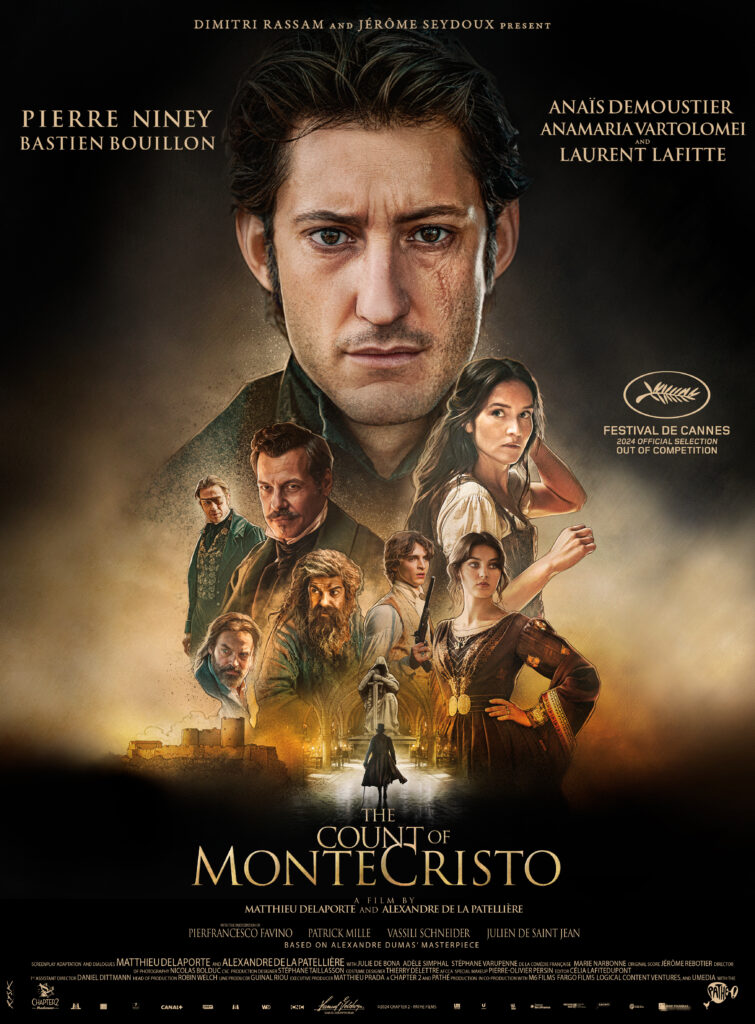The Count Of Monte Cristo: A Detailed Review And Analysis

Table of Contents
Edmond Dantes's Unjust Imprisonment and Transformation
Edmond Dantes's journey from a naive, hopeful young sailor to the cunning and wealthy Count of Monte Cristo is a testament to the human spirit's resilience. His transformation is the cornerstone of The Count of Monte Cristo, driving the plot and shaping the narrative's core themes.
The Betrayal: A Web of Deceit
Edmond Dantes's downfall stems from a cruel conspiracy orchestrated by three envious men: Fernand Mondego, a jealous rival in love; Danglars, a treacherous shipmate consumed by ambition; and Villefort, a power-hungry prosecutor.
- Danglars: Driven by greed and resentment, Danglars falsely accuses Edmond of treason, setting the wheels of his destruction in motion.
- Fernand Mondego: Fueled by jealousy over Edmond's relationship with Mercédès, Fernand adds his voice to the conspiracy, contributing to Edmond's wrongful conviction.
- Villefort: Ambitious and fearful of the implications of a letter revealing a past crime, Villefort ensures Edmond's imprisonment, effectively sealing his fate.
The psychological impact of unjust imprisonment is profoundly depicted. Edmond's confinement shatters his spirit initially, leaving him feeling betrayed and hopeless.
The Island of Monte Cristo: A Crucible of Change
Imprisoned in the Château d'If, Edmond endures years of isolation and despair. However, this seemingly hopeless situation becomes a crucible for his transformation. His time on the island proves pivotal:
- Acquisition of Knowledge and Skills: Edmond's imprisonment becomes an unexpected opportunity for self-improvement. He learns fencing, multiple languages, and various other skills from his mentor, Abbé Faria.
- The Abbé Faria: A Guiding Light: Abbé Faria, a fellow prisoner, acts as a mentor and guide, sharing his vast knowledge and shaping Edmond's plan for revenge. He teaches Edmond not only practical skills, but also inspires him with a thirst for knowledge and justice.
- The Discovery of Treasure: The discovery of a hidden treasure on the island provides Edmond with the financial means to enact his elaborate revenge.
This transformative experience on the Island of Monte Cristo fundamentally alters Edmond, forging his path towards becoming the sophisticated and resourceful Count.
From Prisoner to Count: A Metamorphosis
Edmond's emergence from the depths of despair as the Count of Monte Cristo is a dramatic and compelling metamorphosis.
- Physical Transformation: He adopts a refined and elegant appearance, shedding his former simple attire for the finery of a wealthy nobleman.
- Social Transformation: He seamlessly integrates himself into high society, wielding his wealth and intellect to manipulate those who wronged him.
- Psychological Transformation: He develops an unwavering resolve, a keen intellect, and a chilling ability to orchestrate elaborate schemes of revenge.
The Elaborate Schemes of Revenge
The Count of Monte Cristo's revenge is not impulsive; it's meticulously planned and executed with chilling precision. Each act of retribution is tailored to the specific crime and the perpetrator's vulnerabilities.
Danglars's Downfall: A Financial Ruin
The Count methodically dismantles Danglars's financial empire, exposing his fraudulent schemes and reducing him to ruin.
- Manipulation of the Stock Market: The Count manipulates the stock market, causing Danglars to lose his fortune and social standing.
- Exposure of Corruption: He exposes Danglars's corrupt dealings, resulting in further financial and social ruin.
- Family Discord: He even sows discord within Danglars' family, highlighting the far-reaching impact of his revenge.
The effectiveness of this calculated revenge is undeniable, showcasing the Count’s intellect and planning skills, but also raising questions about the moral implications of such actions.
Fernand Mondego's Punishment: Public Humiliation
Fernand Mondego’s punishment revolves around public humiliation and the destruction of his reputation.
- Exposure of Treachery: The Count exposes Fernand's lies and betrayal, shattering his carefully constructed image of a war hero.
- Social Ostracism: Fernand is stripped of his honors and is subjected to public scorn and social isolation.
- Loss of Family and Fortune: Fernand's carefully built life crumbles, mirroring the destruction he helped bring upon Edmond.
The impact of Fernand’s punishment underscores the social consequences of betrayal and the devastating impact of lies.
Villefort's Ruin: A Crumbling Empire
Villefort's downfall is particularly tragic, as it involves the destruction of his career and family.
- Exposure of Past Crimes: The Count unveils Villefort's hidden past, highlighting his role in concealing a crime and his contribution to Edmond's false imprisonment.
- Loss of Position and Power: Villefort's career is shattered as the truth comes to light.
- Family Tragedy: The consequences of Villefort's actions ripple through his family, leading to further tragedy.
The Count’s actions against Villefort highlight the complex and morally ambiguous nature of revenge, questioning the long-term impact of his actions on all those involved.
Themes of Justice, Revenge, and Redemption
The Count of Monte Cristo is not simply a tale of revenge; it is a profound exploration of justice, morality, and the possibility of redemption.
The Nature of Justice: A Broken System
The novel contrasts the official legal system, which fails Edmond utterly, with the Count’s own brand of retribution.
- Limitations of Formal Justice: The novel depicts the shortcomings of the legal system, emphasizing how easily justice can be subverted.
- The Count's Justice: The Count’s actions demonstrate a form of vigilante justice, dispensing punishment according to his own sense of fairness.
- Moral Ambiguity: However, this raises critical questions about whether his methods are justifiable, despite the blatant injustice he initially faced.
This contrast highlights the complexities of justice and the limitations of formal legal processes.
The Moral Ambiguity of Revenge: A Vicious Cycle?
The novel forces readers to confront the ethical dilemmas inherent in revenge.
- Consequences of Revenge: The Count's actions have devastating consequences not only for his enemies but also for their families and loved ones.
- The Cycle of Violence: His pursuit of revenge raises the question of whether it perpetuates a cycle of violence, ultimately leaving everyone involved scarred.
- Justification vs. Morality: The line between justifiable retribution and morally reprehensible actions is constantly blurred.
The ethical considerations surrounding the Count's actions add depth and complexity to the narrative.
Redemption and Forgiveness: A Chance for Renewal?
Despite the dark themes of revenge, The Count of Monte Cristo explores the possibility of redemption.
- Edmond's ultimate goals: While seeking revenge, Edmond also seeks to find peace and move beyond the hatred that has consumed him.
- Mercedes's forgiveness: The novel portrays instances of forgiveness, such as Mercedes’s eventual forgiveness.
- A path to atonement: Some characters find a way to atone for their past mistakes.
The Count of Monte Cristo's Enduring Legacy
The Count of Monte Cristo remains a timeless classic, captivating readers and inspiring numerous adaptations.
The Novel's Popularity: A Cultural Phenomenon
The enduring appeal of this classic novel stems from its captivating narrative, complex characters, and timeless themes.
- Numerous Adaptations: The Count of Monte Cristo has been adapted countless times into film, television, and stage productions, solidifying its status as a cultural landmark.
- Translation and accessibility: The novel has been translated into numerous languages, making it accessible to a global audience.
- Enduring Themes: The powerful themes continue to resonate with audiences across generations.
Its sustained popularity attests to its literary merit and universal appeal.
Relevance to Modern Audiences: A Timeless Story
The novel’s themes remain powerfully relevant in the 21st century.
- Betrayal in Politics and Business: The themes of betrayal and ambition resonate strongly in today’s political and corporate landscapes.
- Injustice and Corruption: The novel's exploration of injustice and corruption continues to hold relevance in modern society.
- The Pursuit of Revenge: The enduring human desire for revenge and justice continues to be a powerful force in our world.
The enduring relevance of The Count of Monte Cristo speaks to its capacity to reflect on human nature.
Conclusion: A Thrilling Journey Awaits
The Count of Monte Cristo is more than just a thrilling adventure; it is a profound exploration of justice, revenge, and the enduring power of the human spirit. Its intricate plot, memorable characters, and timeless themes continue to captivate readers worldwide. Experience (or re-experience) the gripping tale of Edmond Dantes's rise from prisoner to Count, and delve into the complex moral and ethical questions raised within its pages. Further research into Alexandre Dumas and his other works will provide even deeper insights into this remarkable author's literary contributions. Don't delay – embark on your own journey with The Count of Monte Cristo today!

Featured Posts
-
 The Count Of Monte Cristo A Modern Look At A Classic Swashbuckler
May 04, 2025
The Count Of Monte Cristo A Modern Look At A Classic Swashbuckler
May 04, 2025 -
 Bradley Cooper And Will Arnett Behind The Scenes Photos From Is This Thing On Set
May 04, 2025
Bradley Cooper And Will Arnett Behind The Scenes Photos From Is This Thing On Set
May 04, 2025 -
 Is The Count Of Monte Cristo Still Relevant A Modern Review
May 04, 2025
Is The Count Of Monte Cristo Still Relevant A Modern Review
May 04, 2025 -
 Where And When To Watch Canelo Vs Golovkin Ppv Fight Details
May 04, 2025
Where And When To Watch Canelo Vs Golovkin Ppv Fight Details
May 04, 2025 -
 Gold Price Dips Consecutive Weekly Losses In 2025
May 04, 2025
Gold Price Dips Consecutive Weekly Losses In 2025
May 04, 2025
Latest Posts
-
 Kentucky Derby 2025 Pace Prediction Key Horses And Their Impact
May 05, 2025
Kentucky Derby 2025 Pace Prediction Key Horses And Their Impact
May 05, 2025 -
 The 2025 Kentucky Derby Pace Scenarios And Their Implications
May 05, 2025
The 2025 Kentucky Derby Pace Scenarios And Their Implications
May 05, 2025 -
 Examining The 2025 Kentucky Derby Anticipating The Winning Pace
May 05, 2025
Examining The 2025 Kentucky Derby Anticipating The Winning Pace
May 05, 2025 -
 Kentucky Derby 2025 Factors Influencing The Race Pace
May 05, 2025
Kentucky Derby 2025 Factors Influencing The Race Pace
May 05, 2025 -
 Colonial Downs Stones Big Announcement The Virginia Derby Is Coming
May 05, 2025
Colonial Downs Stones Big Announcement The Virginia Derby Is Coming
May 05, 2025
